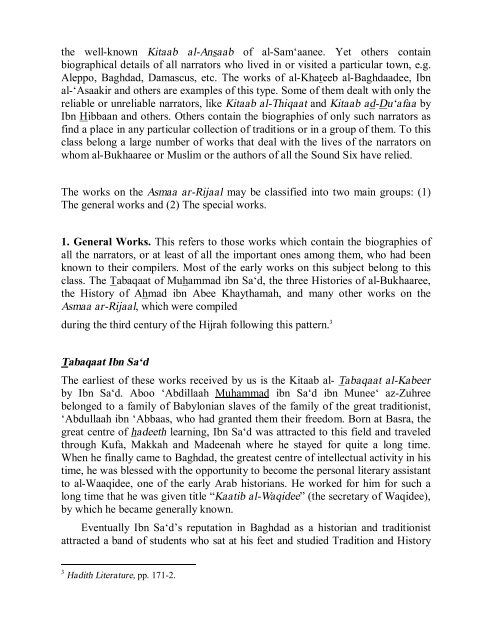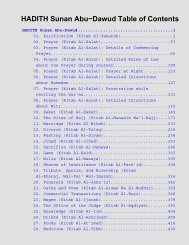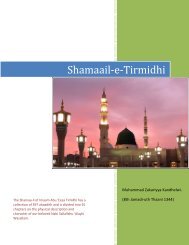NINE: BiographiesScholars of hadeeth re<strong>al</strong>ized the importance of chronology, biography andcriticism from the beginning of the narration of hadeeths. Consequently, like <strong>al</strong>lof the other elements of this science, independent works de<strong>al</strong>ing with narratorsand chronology appeared before the end of the second century.The actu<strong>al</strong> beginning point is difficult to determine, however, Ibn Nadeemmentioned two books in his Fihrist as Kitaab at-Taareekh by ‘Abdullaah ibn <strong>al</strong>-Mubaarak and the other by <strong>al</strong>-Layth ibn Sa‘d (d. 781CE). Al-Waaqidee andHaytham ibn ‘Adee, both of whom died at the beginning of the third century, dida number of works which served as important sources for later writers like, Kitaabat-Tabaqaat, Kitaab Tabaqaat man Rawaa ‘anin-Nabee (The Book of Levels ofThose Who Narrated from the Prophet), etc. 1By the third century, the compilation of biographies, which came to bec<strong>al</strong>led Asmaa ar-Rija<strong>al</strong> or Kutub ar-Rija<strong>al</strong>, <strong>al</strong>most every traditionist of reputecompiled simultaneously with his collection of narrations, some biographies ofthe narrators. All of the compilers of the Sound Six have to their credit one ormore important books on the biography of the narrators. There <strong>al</strong>so appearedspeci<strong>al</strong>ists like; Ibn Sa‘d (230AH/884), Kh<strong>al</strong>eefah ibn <strong>al</strong>-Khayaat, and Ibn AbeeKhaythamah (d. 279AH/892 CE).The magnitude of these biographic<strong>al</strong> dictionaries may be understood fromthe large number of narrators whose biographies they contain. Ibn Sa‘d’sTabaqaat contains the biographies of more than 4,000 traditionists. Al-Bukhaaree’s Taareekh de<strong>al</strong>s with more than 42,000 traditionists. Al-Khateeb<strong>al</strong>-Baghdaadee in his History of Baghdad, gives short biographies of 7,831 persons.Ibn ‘Asaakir in the eighty volumes of his History of Damascus, collected togetherthe biographies of a much larger number of people. Ibn Hajar in his Tahtheeb at-Tahtheeb and Meezaan <strong>al</strong>-I‘tida<strong>al</strong>, summarized the biographic<strong>al</strong> references of12,415 and 14,343 narrators of traditions respectively. 2The works on the Asmaa ar-Rija<strong>al</strong>, however, differ from one another in theirscope, their gener<strong>al</strong> plan, and the detailed nature of their contents, according tothe main object of their compilers and authors. Some of them, like the Tabaqat <strong>al</strong>-Huffaaz of Thahabee, and various other works on weak or un-reliable narrators,contain extremely short notices on a particular class of narrators of traditions.Others de<strong>al</strong> with only the narrators’ names, pet names (kunyah) and their titles(nisbah). Examples of this type are the various works on Asmaa w<strong>al</strong>-Kunaa, and1 <strong>Hadith</strong> Literature, pp. 168-9.2 <strong>Hadith</strong> Literature, pp. 170-1.
the well-known Kitaab <strong>al</strong>-Ansaab of <strong>al</strong>-Sam‘aanee. Yet others containbiographic<strong>al</strong> details of <strong>al</strong>l narrators who lived in or visited a particular town, e.g.Aleppo, Baghdad, Damascus, etc. The works of <strong>al</strong>-Khateeb <strong>al</strong>-Baghdaadee, Ibn<strong>al</strong>-‘Asaakir and others are examples of this type. Some of them de<strong>al</strong>t with only thereliable or unreliable narrators, like Kitaab <strong>al</strong>-Thiqaat and Kitaab ad-Du‘afaa byIbn Hibbaan and others. Others contain the biographies of only such narrators asfind a place in any particular collection of traditions or in a group of them. To thisclass belong a large number of works that de<strong>al</strong> with the lives of the narrators onwhom <strong>al</strong>-Bukhaaree or Muslim or the authors of <strong>al</strong>l the Sound Six have relied.The works on the Asmaa ar-Rija<strong>al</strong> may be classified into two main groups: (1)The gener<strong>al</strong> works and (2) The speci<strong>al</strong> works.1. Gener<strong>al</strong> Works. This refers to those works which contain the biographies of<strong>al</strong>l the narrators, or at least of <strong>al</strong>l the important ones among them, who had beenknown to their compilers. Most of the early works on this subject belong to thisclass. The Tabaqaat of Muhammad ibn Sa‘d, the three Histories of <strong>al</strong>-Bukhaaree,the History of Ahmad ibn Abee Khaythamah, and many other works on theAsmaa ar-Rija<strong>al</strong>, which were compiledduring the third century of the Hijrah following this pattern. 3Tabaqaat Ibn Sa‘dThe earliest of these works received by us is the Kitaab <strong>al</strong>- Tabaqaat <strong>al</strong>-Kabeerby Ibn Sa‘d. Aboo ‘Abdillaah Muhammad ibn Sa‘d ibn Munee‘ az-Zuhreebelonged to a family of Babylonian slaves of the family of the great traditionist,‘Abdullaah ibn ‘Abbaas, who had granted them their freedom. Born at Basra, thegreat centre of hadeeth learning, Ibn Sa‘d was attracted to this field and traveledthrough Kufa, Makkah and Madeenah where he stayed for quite a long time.When he fin<strong>al</strong>ly came to Baghdad, the greatest centre of intellectu<strong>al</strong> activity in histime, he was blessed with the opportunity to become the person<strong>al</strong> literary assistantto <strong>al</strong>-Waaqidee, one of the early Arab historians. He worked for him for such <strong>al</strong>ong time that he was given title “Kaatib <strong>al</strong>-Waqidee” (the secretary of Waqidee),by which he became gener<strong>al</strong>ly known.Eventu<strong>al</strong>ly Ibn Sa‘d’s reputation in Baghdad as a historian and traditionistattracted a band of students who sat at his feet and studied Tradition and History3 <strong>Hadith</strong> Literature, pp. 171-2.
- Page 2:
[Usool Al Hadeeth]The Methodology o
- Page 6 and 7:
from the Prophet of his actions, sa
- Page 8 and 9:
3. LawsOne of the primary duties of
- Page 10 and 11:
authentically attributable to the P
- Page 12 and 13:
was asked which city will be conque
- Page 14 and 15:
Rahmaan, who was at that time the m
- Page 16 and 17:
centuries. They also grouped the ha
- Page 18 and 19:
Prophet's lifetime, and in the wars
- Page 20 and 21:
JAABIR IBN ‘ABDILLAAH. One of the
- Page 22 and 23:
2. ‘Ard : Reading by the Students
- Page 24 and 25:
Transmission TerminologyThe hadeeth
- Page 26 and 27:
EVOLUTION OF THE SANADTeaching the
- Page 28 and 29:
the Sahaabah had left off and began
- Page 30 and 31:
In this case the Sanad is shorter b
- Page 32 and 33:
The Pattern of IsnaadThe usual patt
- Page 35 and 36:
Origins of the Isnaad SystemEvery t
- Page 37 and 38:
FOUR: ClassificationDue to a variet
- Page 39 and 40:
Hadeeth SaheehA hadeeth must meet t
- Page 41 and 42:
Saheeh li GhayrihThe hadeeth saheeh
- Page 43 and 44:
ecorded by others.5. Authentic hade
- Page 45 and 46:
Abee Awfaa wrote to him saying that
- Page 47 and 48:
Muhammad ibn Bashshaar informed us
- Page 49 and 50:
Ruling on Da‘eef NarrationsSchola
- Page 51 and 52:
In this narration, he deleted the c
- Page 53 and 54:
called Taghleeq at-Ta‘leeq (Closi
- Page 55 and 56:
The jurists (fuqahaa) generally def
- Page 57 and 58:
Caesar’s emissary collected by Ah
- Page 59 and 60:
Muwatta 42 with the following chain
- Page 61 and 62:
Saqiyah called him Aboo Wahb al-Asa
- Page 63 and 64:
Khateeb al-Baghdaadee’s book call
- Page 65 and 66:
The Mu’annan is a hadeeth in whic
- Page 67 and 68:
and the household of the Prophet (r
- Page 69 and 70:
The supporters of each opinion fabr
- Page 71 and 72:
(Soorah al-Israa, 17: 79) he said t
- Page 73 and 74:
7. Inventions for Personal Motives:
- Page 75 and 76:
Zamakhasharee and ash-Shawkaanee.Li
- Page 77 and 78:
definitions by other scholars are:1
- Page 79 and 80:
FIVE: ConflictIn vast number of nar
- Page 81 and 82:
farewell Hajj as well as on other o
- Page 83 and 84:
caught) but on the fourth occasion
- Page 85 and 86:
hadeeth narrations. So much so that
- Page 87 and 88:
Mulaykah, 14 az-Zuhree 15 and Shu
- Page 89 and 90: them in ash-Sha‘bee’s direction
- Page 91 and 92: ased on the relative reliability of
- Page 93 and 94: Step Four: The eras of the narrator
- Page 95 and 96: ) متواتِر بِال ْمعن
- Page 97 and 98: have even claimed Ijmaa‘ (unanimi
- Page 99 and 100: What further explains this Qur’aa
- Page 101 and 102: Bukhaaree - the most correct book a
- Page 103 and 104: 3. ‘Abdullaah ibn ‘Umar said:
- Page 105 and 106: of scholars. It is false because it
- Page 107 and 108: This hadeeth was narrated from Anas
- Page 109 and 110: the view that discrepancies between
- Page 111 and 112: EIGHT: LiteratureThe origins of the
- Page 113 and 114: collected hadeeths which were relat
- Page 115 and 116: Ibn Hambal began lecturing on tradi
- Page 117 and 118: students, and also to his sons and
- Page 119 and 120: The final chapter is on Shamaa’il
- Page 121 and 122: On many occasions al-Bukhaaree’s
- Page 123 and 124: Saheeh of Muslim ibn al-Hajjaaj ibn
- Page 125 and 126: have examined 500,000 hadeeths, and
- Page 127 and 128: Islamic world. 43 Sunan Abee Daawoo
- Page 129 and 130: them on account of its isnaad. I he
- Page 131 and 132: Muslim. 56 The book does, however,
- Page 133 and 134: Ad-Daaraqutnee rapidly acquired a s
- Page 135 and 136: men had to be appointed to repeat h
- Page 137 and 138: The Zawaa’id Work of al-Haythamee
- Page 139: (iv) They had been used as a basis
- Page 143 and 144: notices of more than 40,000 narrato
- Page 145 and 146: Zaynud-Deen al-‘Iraaqee (725-806/
- Page 147 and 148: forced to leave the city and wander
- Page 149 and 150: the author. But the work could not
- Page 151 and 152: TEN: Women Scholars of HadeethHisto
- Page 153 and 154: daughter of the distinguished juris
- Page 155 and 156: turn lectured to many students, som
- Page 157 and 158: excelled in the art of calligraphy
- Page 159 and 160: occurs only in Mutayyin’s narrati
- Page 161 and 162: Abu Bakr as-Siddeeq, then to Ali ib
- Page 163 and 164: ف َأ َمسك َها ف َل
- Page 165 and 166: Haakim, Muhammad ibn ‘Abdillaah a
- Page 167: Thahabee, Muhammad ibn Ahmad ath-.





